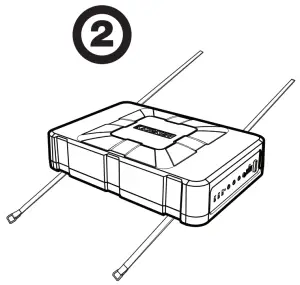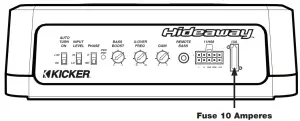KICKER 11HS8 8″ 150W Hideaway Car Audio Powered Subwoofer
INSTALLATION
Mounting: Choose a structurally sound location to mount your KICKER powered subwoofer enclosure. Carefully check the areas where the mounting straps will be placed. Make sure the mounting screws will not puncture the gas tank/brake lines/wiring or interfere with any mechanical parts on the underside of the mounting surface. Choose a location that allows at least 4″ (10cm) of open ventilation for the amplifier. If possible, mount the enclosure in the climate-controlled passenger compartment.


Bracket mounting: Mount the brackets to the bottom of the enclosure using the supplied smaller screws. Securely attach the enclosure to the vehicle with the supplied larger screws.2011 Hideaway Rev Pined 3
Wiring:

Observe the polarity of input connections to avoid signal loss.Use the KICKER KISL for source units with RCA outputs or splice the quick-connect harness leads directly to your source unit’s speaker-level outputs.If using an LOC please ensure that it is not wired in reverse. Failure to do so will result in little to no output. KICKER recommends using the KISL as shown above.
quick-connect harness audio inputs:
| White | Left + |
| White/Black | Left – |
| Grey | Right + |
| Grey/Black | Right – |

Automatic Turn-On Selection: KICKER powered enclosures offer two different automatic turn-on modes that can be selected on the side panel; +12V and DC Offset. Using the DC Offset mode causes the REM terminal to have +12V out for turning on additional amplifiers.
- Remote Turn-On: Set the switch to +12V to use the remote turn-on lead from your source unit. Run 18 gauge wire from the Remote Turn-On Lead on your source unit to the terminal labeled REM on the quick connect power harness. This is the preferred automatic turn-on method.
- DC Offset Turn-On: If Remote Turn-On is not an option, the next best setting is DC Offset. The DC Offset mode detects a DC offset from the HI-Level speaker outputs when the source unit has been turned on.
Phase Switch: The phase switch lets you invert the phase of the signal played through your powered subwoofer. This is useful if the speakers in your system are out of phase with the subwoofer. Toggle this switch to find the position that gives you the best bass response.
Input Level: The inputs on KICKER powered enclosures are capable of receiving either Hi (speaker-level) or Low-level (RCA) signals from your source unit. Set the Input Level switch on the side panel to match the outputs of your source unit.
Crossover Control: The variable crossover on the side panel allows you to adjust the crossover frequency from 50120Hz. The setting for this control is subjective; 80Hz is a good place to start.
Input Gain Control: The input gain control is not a volume control. It matches the output of the source unit to the input level of the powered enclosure’s amplifier. Turn the source unit up to about 3/4 volume (if the source unit goes to 30, turn it to 25). Next, slowly turn the gain on the powered enclosure up (clockwise) until you can hear audible distortion, then turn it down a little.
Bass Boost Control: The variable bass boost control on the side panel is designed to give you increased output (06dB) at 40 Hz. The setting for this control is subjective. If you turn it up, you must readjust the input gain control to avoid clipping the powered enclosure’s amplifier.
Remote Bass Control: With the included remote bass control, you have the ability to control the output level of your powered enclosure remotely. When plugged into the enclosure, the remote bass control bypasses and takes the place of the gain control on the side panel. To mount the remote bass level control, simply screw the metal bracket to the chosen location, then slide the housing onto the bracket until it snaps into place. Run the cable from the controller to the “Remote Bass” jack on your powered enclosure’s side panel. DO NOT disconnect the remote bass control when the amplifier is on!
REMOTE BASS CONTROL INSTALLATION

TROUBLESHOOTING
If your amplifier does not appear to be working, check the obvious things first such as blown fuses, poor or incorrect wiring connections, incorrect setting of crossover and gain controls, etc. There is a dual-stage PWR/ PRT LED on side panel of your powered enclosure denoting the power state of the amplifier. When the LED is blue, this indicates the powered enclosure is turned on and its amplifier is functioning properly.
PWR/PRT LED off, no output? With a Volt Ohm Meter (VOM) check the following: ![]() +12 volt power terminal (should read +12V to +16V)
+12 volt power terminal (should read +12V to +16V) ![]()
![]()
![]()
![]()
![]()
![]()
![]()
![]()
![]()
![]()
![]()
![]()
![]()
![]()
![]()
![]()
![]()
![]()
![]()
![]()
![]()
![]()
![]()
![]()
PWR/PRT LED blue, no output? Check the following: ![]()
![]()
![]()
![]()
![]()
![]()
![]()
![]()
![]()
![]()
![]()
![]()
![]()
![]()
![]()
![]()
![]()
![]()
![]()
![]()
![]()
![]()
![]()
![]()
![]()
![]()
![]()
PWR/PRT LED red, no output? ![]()
![]()
![]()
![]()
![]()
![]()
![]()
![]()
![]()
![]()
![]()
![]()
![]()
![]()
![]()
![]()
![]()
![]()
![]()
![]()
![]()
![]()
No or low output? ![]()
![]()
![]()
![]()
![]()
![]()
![]()
![]()
![]()
![]()
![]()
![]()
![]()
![]()
![]()
![]()
![]()
![]()
![]()
![]()
![]()
![]()
![]()
![]()
![]()
![]()
![]()
Alternator noise-whining sound with engine’s RPM? ![]()
![]()
![]()
![]()
![]()
![]()
![]()
![]()
![]()
![]()
![]()
![]()
![]()
![]()
![]()
![]()
![]()
![]()
![]()
![]()
![]()
![]()
![]()
![]()
![]()
![]()
![]()
![]()
![]()
![]()
![]()
![]()
![]()
Reduced bass response? Flip the phase switch to the opposite position; if the bass improves, your speakers were out of phase with the subwoofer.
Ground Noise? KICKER amplifiers are engineered to be fully compatible with all manufacturers’ head units. Some head units may require additional grounding to prevent noise from entering the audio signal. If you are experiencing this problem with your head unit, in most cases running a ground wire from the RCA outputs on the head unit to the chassis will remedy this issue. If you still have problems, run your input signal at speaker-level from your source unit to the amplifier.
CAUTION: When jump starting the vehicle, be sure that connections made with jumper cables are correct. Improper connections can result in blown amplifier fuses as well as the failure of other critical systems in the vehicle.
If you have more questions about the installation or operation of your new KICKER product, see the Authorized KICKER Dealer where you made your purchase. For more advice on installation, click on the SUPPORT section on the KICKER homepage, www.kicker.com . Please E-mail or call Technical Services (405) 624-8583 for unanswered or specific questions.
References
[xyz-ips snippet=”download-snippet”]


